
This article is based on the webinar we co-presented with Rand Fishkin from Moz. Dr Karl Blanks’s section of the talk has been moved into a separate article, “Five common conversion mistakes we’ve made and seen.” The article you are currently reading began life as a transcript, but transcripts are hard to read. We believe that the content is too important to be buried in a transcript, so we have heavily copy-edited it. Think of this as a transcript-article. A transcr-article.
What you’ll get from this transcr-article
Karl: Hello, everyone. Welcome to today’s webinar, which is about how conversion can help with your SEO. I’m Karl Blanks and today my co-presenter—my co-star—is Rand Fishkin. Rand is the founder of Moz, and is one of the world’s leading authorities on SEO.
On today’s call, we are going to cover the following:
- Sometimes you should focus on conversion rate optimization (CRO) and sometimes you should focus on search engine optimization (SEO). Rand will describe when to focus on CRO versus SEO.
- Does CRO harm SEO? And does SEO harm CRO? Many companies depend on SEO for their livelihoods. They are understandably scared to carry out CRO, worrying that it may damage their SEO rankings. Rand will explain how CRO and SEO affect each other.
- We’ll have a Q&A session. I know there are many things that you would love to be able to ask Rand. Rand doesn’t often speak about conversion, so this is a rare opportunity.
So welcome, Rand.
Rand: Thanks for having me, Karl.
Karl: You’re always welcome. As I mentioned, everyone, Rand is the founder of Moz. If you don’t know Moz already, I urge you take a look at its site. Moz is an extremely credible company, and it has some fantastic tools that we use on our website and recommend to our clients. A few years ago, I heard HubSpot’s founder, Dharmesh Shah, say something like: “Think of what companies were like 50 years ago. Many of the things they did are now seen to be crude or controversial. There has been a huge culture change in many respects: gender equality, awareness of the environment, health and safety, and transparency. Already, many practices of the 1970s seem crude. You just need to look at 1970s advertising. Now consider that culture is likely to change at least as much, probably more, in the next 30 or 40 years. Think of which current practices will seem equally outdated.”
Rand has crafted a company culture that already makes many of today’s companies seem out-dated. He has embodied them in his company culture document, which he calls the TAGFEE code. I’d recommend you read it. It’s innovative, and we believe it’s a glimpse of the future.
Rand, at this point I should pass over to you, rather than talking about how great you are. Do you want to kick off?
When to focus on CRO vs. SEO
Rand: That’s very kind. Yeah, I’m happy to get started. I specifically want to talk about some mistakes we made and mistakes that we’ve seen. I particularly want to discuss misconceptions about how CRO and SEO are supposed to work together,do work together, and sometimes don’t work together. I’m going to start with some very high-level stuff.
The first part of this is about landing pages. There are some key differences in how marketers and website builders need to think about the architecture for the pages they want their visitors to land on, and the different use cases that the marketers have.
In the past at Moz, we had a misconception. Some of our pages were for SEO and content marketing:
- Driving brand traffic.
- Growing our authority with Google.
- Earning links, mentions, social shares and email referrals.
- Earning loyalty, trust and brand exposure.
- Earning positive social shares and links and engagement.
We wrongly believed that those pages were the same pages on which we would have people convert to taking our free trial or buying our software or our API. That was poor thinking. These pages are very different from a landing page for a conversion purpose.
How to optimize pages for SEO and content marketing
The following slide shows a recent Moz blog post by Craig Bradford.
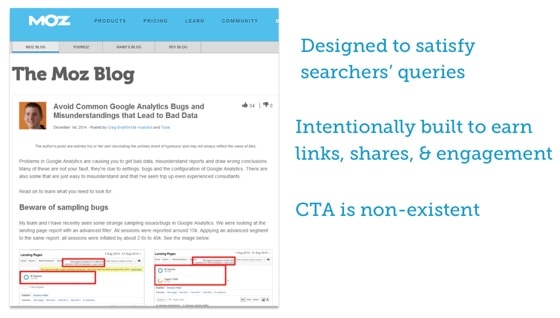
A page built for SEO and content marketing.
I thought it was excellent. It talks about all these Google Analytics bugs and mistakes that lead to bad data. In fact, speaking of mistakes, Moz has made some of the mistakes that Craig talked about in this blog post. Super-useful post, right? But it is designed to do something very different than a landing page that would help with the conversion process, right? This blog post is designed to help marketers succeed at their work, to help them use Google Analytics better, to have them build a positive association with Moz, and to get to our website.
And I know that 90+ percent of the people who get to this page are probably just going to read this blog post. And then my hope is that some percent of them will Tweet it or put it on Facebook, Google+ or LinkedIn or social network of their choice. A few will email it to their boss or their team, a few will comment on it, and the vast majority will read it, consume it, and then go away. And you might think, “Well, what are you gaining in that, Rand? What is Moz deriving value from there?” And the answer is the value that’s derived is one touch among many.
What many marketers don’t realize—and even those of us who do realize, we still make the mistake—is that we think about our marketing funnel as being single track. We think: “We want someone to come to this blog post. Now where is the call to action that’s going to send them to take a free trial? And what percent of those people can we get to the free trial? And what percent of those do we get to the cart? And what percent of those will sign up? And what percent of those will stay for their first month and invest?”
And that’s poor short-term thinking. Well, it’s good short-term thinking, but it’s bad long-terming thinking. The call to action (CTA) here is non-existent.
How to optimize pages in the conversion funnel
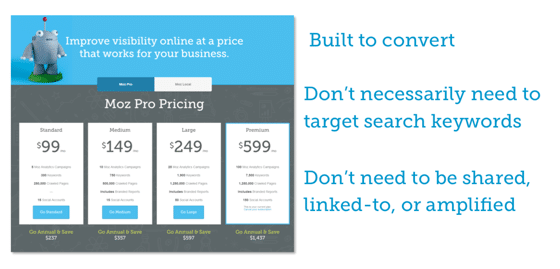
A page from Moz’s conversion funnel. The live page is here.
The page above is in Moz’s conversion funnel. Until now, I hadn’t seen our new pricing page; we just redesigned this. It’s kind of pretty. I think our mascot, Roger, looks cute there. But this page in our conversion funnel is built to convert. It’s a pricing page—it’s going to let you choose which price. It doesn’t need to target any search keywords. It doesn’t need to be shared or linked to or amplified (although a few people have shared it, Tweeted it, put it on Google+, and that kind of thing). But it doesn’t need those things, I’m not trying to get this page to rank for something. The only thing I really would want it to rank for is “Moz Pro pricing.” But otherwise, I don’t want this page to rank for “SEO tools,” or “better SEO,” or “help my site.” That’s the job of content.
Here’s how Moz’s funnel works. (Marketers are fascinated when they hear this, and I’m impressed that our team has been able to measure this.) I think it is seven-and-a-half visits to Moz’s website, on average, before someone takes a free trial. Four or five of those are usually to content, not to the sales pages, not to the pricing page or anything that’s in our funnel. And usually two of those touches come from social, a few come from organic search, usually one or two are direct. So we’re talking about a complex mix of people coming to us for a multitude of reasons, and landing on a variety of pages before they ever get to the free trial.
Here’s the most interesting part: If you visit us only two or three times before you take a free trial, you usually don’t end up staying with the subscription as long.You usually don’t even get through the free trial into the paid months. So in a weird twist of fate, I don’t want to convert you, right? It is not in Moz’s interest to convert someone on their first visit or their second visit or even their third or fourth visit. In fact, if you visit ten or more times before you convert, you tend to be an excellent customer; you stay subscribed much longer than the people who subscribed after having visited only three or four times. And so that’s why we have such separation between the content marketing and the conversion-focused funnel.
How to optimize pages for SEO and conversion
Now I want to make a caveat, which is that not everyone operates the same way Moz does; sometimes you will have pages that are both conversion-focused and trying to rank for something directly. The following page tries to do both:
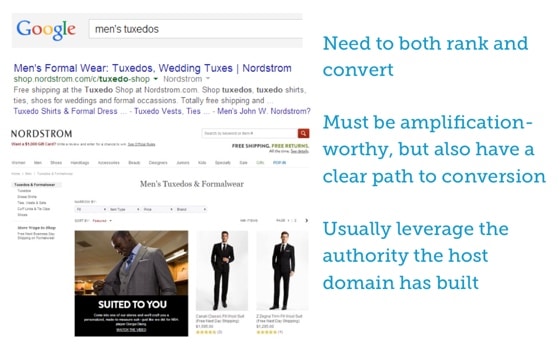
A page that’s designed for SEO and conversion.
I searched for “men’s tuxedos” in Google, and I got to Nordstrom’s website. I don’t particularly think highly of either of those tuxedos, but they do have one from Ted Baker, a Scottish designer who I think is phenomenal. This page, “Men’s Tuxedos and Formal Wear,” needs to both do a great job of ranking and be worthy of amplification. It needs to combine both.
Interestingly, this page ranks not because it has the most links of any page about men’s tuxedos, and not because it has the most shares, the best engagement, or those kinds of things; this page ranks because of the overall site’s domain authority. That’s how many, many pages that are both content and conversion-focused rank.
So when you ask, “Why is this page performing so well for this query?,” the answer is, “Because Nordstrom is a brand that, on and off the web, has built a remarkable reputation on all of the positive signals around its brand and its website as a whole.” And that’s why Google is ranking this page higher than a page that is on, say, MensTuxedos.com, that is hyperfocused and has done a bit more of that classic SEO stuff right. But Google has evolved past that.
This is a good example of why it pays to have a lot of great content marketing and brand-building content, content that gets you all of those other types of signals, and which is not necessarily conversion-focused. In fact, for a lot of content marketing, the conversion goal shouldn’t be, “Get someone to sign up and pay us,” or, “Get someone to purchase this product”; it should be, “How do we get people to know us, like us, share our stuff, amplify our message, become evangelists, engage with us, and become part of our community?”
That’s the real goal of content marketing.
And then that content marketing, the strength of those signals that you built up, will help all of the pages on your site—including the ones that are conversion-focused. So this is something that we’ve learned over the years, made a lot of errors with, and that I see marketers and business owners struggle with.
Does CRO mess up SEO? (Or can they live in harmony?)
The other big mistake that I find people making is worrying that their CRO efforts are going to mess up their SEO efforts—or vice versa.
I’ve heard conversion specialists say, “We’d love to do SEO on our website and we’d love to get more search traffic, but we just can’t afford to mess with the conversion funnel, because we have optimized these pages for conversion.” To which I shake my proverbial fist in the air and say, “That’s insane. There’s no conflict between the two.”
And the same is true the other way around. If you are doing SEO and you’re thinking to yourself, “Hey, I got my page in perfect condition. Google just loves me, and I’m ranking number one. I don’t want to touch it, man. I don’t want to mess around with CRO and testing different versions of the landing page. What if I change something on the page and Google doesn’t rank me as highly anymore?” That’s crazy too. More proverbial fist-shaking.
What I’m showing here is sacrilegious from an SEO-practitioner standpoint. But I wanted to illustrate a very simplistic model of Google’s algorithm. These are broad elements that factor into a page’s ranking ability.

An over-simplified schematic of Google’s algorithm.
- Keyword and on-page: You get your keywords optimized and your on-page stuff optimized.
- Content quality, which includes everything that Google uses to measure whether a piece of content is high quality. They have sophisticated algorithms around topic modeling and many other kinds of analysis.
- Domain authority describes all the signals that your brand and website have built up from links and shares and engagement, etc. And content quality across the whole site—all that stuff that might go into something like Panda.
- Page authority: the individual shares and links and external signals that affect a page’s ranking ability.
- User and usage data describes things like pogo sticking, when people click on you in the search results, and then click back to the search results because they’re unhappy.
- Spam analysis: Are you doing shady stuff?
All this figures into ranking ability. But changes made to pages for conversion rate optimization (CRO) only affect the following three: (i) keyword, (ii) content quality, and (iii) user and usage data. So that’s good to know, right? Nothing I’m going to do for CRO is going to affect my domain authority, my page authority, or spam analysis negatively. I mean unless I’m doing something absolutely insane. I can’t imagine something that would be logical for CRO that would affect anything but these three.
So if your conversion rate is rising, meaning if you’re doing high-quality CRO, you are positively benefiting two of the things:
- You’re benefiting your content-quality signals; because with content quality, Google is looking at things that would lead people to say, “Yes, I want to buy from this,” “Yes, I want to convert,” “Yes, this is interesting to me.” Those content-quality signals Google uses are going to be correlated with the same things you’re optimizing for.
- And you’re benefiting user and usage data: The more people who are converting, the fewer people who are bouncing away, the more time people are spending on your site, the more they are engaging with you. Ta-da!
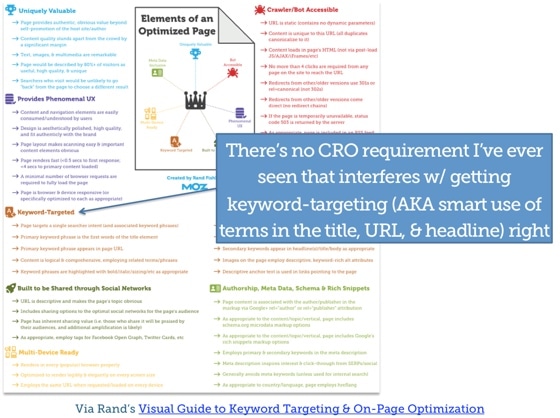
Rand’s guide to keyword-targeting.
So the only one we have to worry about is keyword and on-page. And you almost never need to worry about it if you stick to some basic principles. I’ve never seen a CRO requirement that interferes with getting keyword-targeting right. The basics are:
- You have terms and phrases you want to target, for which you’re trying to rank.So try and get them in the page title, which should almost never affect CRO.When you’re doing CRO, you probably won’t be messing with your HTML page title anyway.
- The URL probably doesn’t matter much for CRO.
- The headline does matter for CRO. But for CRO, you almost certainly want to have the terms and phrases that you’re chasing after in your headline, because you’re trying to create that information set.
And so, almost all the time, these things perfectly align. And even when the alignment is imperfect, you can usually find a satisfactory combination of the two that’s going to work well. So it’s a mistake and a myth to think that you can’t mess with SEO or CRO because of the other one. And I worry about marketers who fear that stuff.
Karl: Rand didn’t want me to mention any call to action, but I’m doing it anyway: If you want to start the free 30-day trial for Moz, then here’s how to do it. And like I mentioned before, it’s a tool that we use and recommend to our clients. It’s so useful.
Rand: You’re mixing my brand and my conversion funnel, Karl.
Karl: I am, Rand, but you’re in my conversion funnel now. This is my slide.
Rand: Oh, okay. Fair enough.
Karl: If your annual revenue is more than $1,000,000, then if you’d like a free phone consultation from Conversion Rate Experts, then go to this page. If you’d like to work for us, go to this page. And if you’d like a free CRO toolkit and lots of useful articles, then go to this page.
Q&A
“Are there any SEO issues, from a technical perspective, about showing different content to different users as part of split-testing software? Does this change if it’s done client-side or server-side?”
Rand: Good question. The answer is almost never. Because usually when you are split-testing, there’s a version that you are by default showing to Google and showing to browsers that aren’t executing more complex JavaScripts. Google can crawl that and see it, but Google is very familiar with split-testing software these days. Obviously, Google has its own A/B-testing software. And as a result, unless you custom-crafted some split-testing software in-house that uses surprisingly simplistic JavaScript, and so somehow you’re showing two versions of a page to Google. But that would be an extremely rare case. And even then, you’re not going to get penalized. Google might cache one version or the other. And if both are relatively SEO-friendly, that shouldn’t concern you too much either.
So the short answer is no, you don’t need to worry about it. Feel free to split-test. The technical issues, as far as Google is concerned, should be virtually non-existent.
Karl: Years ago, SEO spammers used cloaking software that was very similar to split-testing software, where JavaScript redirects would show a different page to a visitor than it showed to Google. So I guess lots of people are still scared.
Rand: The beauty of how SEO evolved is that the version that converts the best is now much better than the version that’s stuffed with keywords. Even for SEO, right? Because keyword usage is such a small part of getting your SEO right, and having high engagement, good conversion rates is such a big part of getting SEO right. And Google is really rewarding that; you can see that over time as they evaluate content quality and user- and usage-data signals and as they get all sorts of scary tracking about what all of us are doing on the web. The incentive for spammers to do that is gone.
Karl: It does genuinely scare many people. In the past, similar techniques could be harmful, couldn’t they?
Rand: Right. The biggest answer to this question is that Google has its own split-testing software: Google Analytics Content Experiments. They also have blog posts from their Webmaster Tools team telling you not to worry about it, and explaining that they recognize the testing software and can figure it out. So you’re very safe on that front.
“How did Moz go about finding out how long it takes visitors to become subscribers? I’m especially interested in how they were able to tie back subscribers to the length of visits to the site.”
Rand: This is how multi-channel attribution works, or is supposed to work. And we have two versions of that. One is a simple version that we did via Google Analytics. The other one is a little more complex, and we did it via a combination of Mixpanel, which we have on our site, and with our own in-house measurement tool called Gizmo.
So we looked at all of our subscribers: people who had taken a free trial, and people who hadn’t. And then we looked at their IP address or the cookie from them. And we looked at ones where the cookie had existed over the course of the last 90 or 180 days, whatever it was. And then we looked at how many times on average they visited the site and which channels on average they came through. And then we built up a model based on that.
You can do that through Google Analytics’ conversion-path tool. They have a system that will show you that. So they’ll have a little blue bar for social, a red bar for search, and yada yada. So you can see that, those paths.
And then, on the slightly more complex side, what we did is break out our subscribers into buckets. So we have, essentially, four buckets:
- People who are in their free trial, the first 30 days of their membership before they convert and pay.
- People who are in their first three months of membership—we call those the non-loyal bucket.
- The loyal bucket, which I think is people who have four to nine months of membership.
- People who have had over nine months of membership. We call them lifers.
We looked at those people and their paths to conversion. The lifers and loyals, on average, had visited many more than 7.5 times. They had made 10, 12, 15 visits before taking a free trial.
Conversely, many of the non-loyal folks, people who lasted between zero and four months, or who didn’t even make it through the free trial, had visited few times (maybe 1–4 times) prior to taking a free trial. If you come to Moz for the very first time and you sign up for a free trial, chances are you’re going to abandon before the first 30 days are over. And I think that shouldn’t be particularly surprising, given our audience. It’s relatively intuitive. But having the data to be able to prove to your management or your team is just invaluable.
So this is important for anyone out there with a subscription service, or where lifetime value and recidivism are important, or with customers who are buying multiple products over multiple visits. I’d urge you to go look at that as a path. It can reveal some fascinating stuff, and it’s not hard to get.
“Do PPC visitors’ usage data affect SEO ranking?”
Rand: Yes-ish, but it can be quite indirect. So the thing that I generally tell folks is, “If, over time, you are improving the happiness of your visitors, Google will reward you.” What we don’t know is how they’re measuring that, and which metrics they take into account. They aren’t pulling data from Google Analytics, but they almost certainly are from clicks on search results, and then bounces back to SERPs. They’re probably getting some data from things like Google+ and Android and Chrome Browser and all of these things where they have access to web-scale usage data.
So you’re okay if you’re improving the rate at which people do the following:
- Browse (the number of pages that someone visits when on your site)
- Convert
- Return to your site
- Search for your brand
- Navigate directly to your pages to solve something
- Seek you out in the search results and prefer you over higher-ranked results because they’re comfortable with your brand.
All of those things probably have a direct or indirect impact on your rankings. And so one of the best things that you can do for SEO these days is to improve usability and user experience. And that fits nicely with conversion rate optimization, because usability and user experience are hugely tied to successful conversions.
Karl: Fantastic. That’s all we’ve got time for. It has been great to have you on the call, Rand.
Rand: Oh my gosh, I love doing this stuff with you, Karl.
Karl: No, likewise, it’s been great. Do you have anything else you’d like to add for the listeners/viewers?
Rand: No, although I do have one quick comment: You need to get on Twitter, man. I’ve been trying to reference you and call you out, but there’s no Twitter account for you or Conversion Rate Exerts that I can find. Get on Twitter.
Karl: I know, we need to.
Rand: The only reason I’m telling you, I want to promote you on Twitter and I can’t and that hurts me, it hurts me in my heart, my social-media-sharing heart.
Karl: Well, thank you very much for that. Yes, I’d appreciate a conversation. Twitter seems like a lot of work, and we try to stay focused, but maybe that’s one of the areas of focus that we are wrong about.
Rand: Even if you just have an account.
Karl: Oh, we do. It’s “crexperts.” We’ve just never Tweeted because it’s time consuming. People spend a lot of time on it.
Rand: It’s an addiction; I’m just trying to get you hooked.
Karl: Exactly. It feels like you are a heroin dealer trying to persuade me to try just a little bit of heroin. But thank you very much for the recommendations.
I should have mentioned that when we were working on Rand’s site, Rand kindly let us give away a screenshot of one of the winning pages that we developed for Moz’s tools. If you go to this page, you can download an extremely long page that we designed for Moz, which has loads of annotations about all the different things that we did.
Great to speak with you, Rand, and great to speak to you, everyone on the call. I look forward to the next time. Have a great day, everyone.
To view the original article Click Here

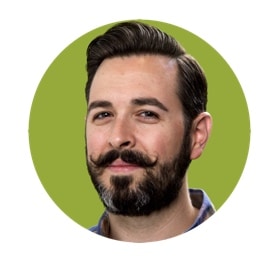
Thanks for the kind comments Akmal! :-)
ReplyDelete